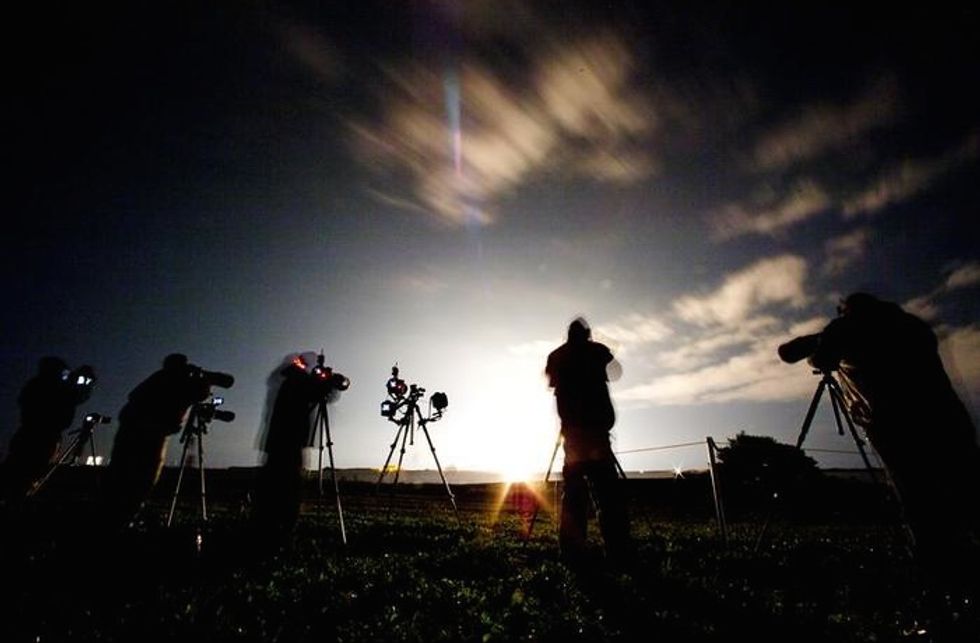CAPE CANAVERAL, Fla. (TheBlaze/AP) — If humanity's going to conquer the stars, some experts say, we don't just need to launch rockets.
We need to recover and reuse them — things just get too expensive otherwise.
Humanity fell a bit short of that goal Saturday morning.
SpaceX pulled off another launch of supplies to the International Space Station on Saturday, but its revolutionary attempt to land the leftover booster on an ocean barge fared less well.
 Photographers record the launch of the Falcon 9 SpaceX from Space Launch Complex 40 at the Cape Canaveral Air Force Station in Cape Canaveral, Fla., Saturday, Jan. 10, 2015. SpaceX is on a resupply mission to the International Space Station. (AP Photo/John Raoux)
Photographers record the launch of the Falcon 9 SpaceX from Space Launch Complex 40 at the Cape Canaveral Air Force Station in Cape Canaveral, Fla., Saturday, Jan. 10, 2015. SpaceX is on a resupply mission to the International Space Station. (AP Photo/John Raoux)
The company's billionaire founder Elon Musk said the first-stage of the unmanned Falcon rocket made it to the platform floating a couple hundred miles off Florida's northeastern coast. But the booster came down too hard and broke apart, he said.
"Close, but no cigar this time," Musk said via Twitter. He said it bodes well for the future, though.
It was the first time anyone tried anything like this, and while many reported the attempt as an ultimate failure, Business Insider noted SpaceX's success at guiding the booster to the landing pad in the middle of the ocean.
Musk, an outspoken advocate of space exploration and colonization of Mars, maintains that recovering and reusing rockets is essential for bringing down launch costs and speeding up operations.
 In this May 29, 2014 file photo, Elon Musk, CEO and CTO of SpaceX, introduces the SpaceX Dragon V2 spaceship at the SpaceX headquarters in Hawthorne, Calif. (AP Photo/Jae C. Hong, File)
In this May 29, 2014 file photo, Elon Musk, CEO and CTO of SpaceX, introduces the SpaceX Dragon V2 spaceship at the SpaceX headquarters in Hawthorne, Calif. (AP Photo/Jae C. Hong, File)
The primary mission for SpaceX was delivering more than 5,000 pounds of supplies ordered up by NASA, including hasty replacements for experiments and equipment lost in the destruction of another company's cargo ship last fall, as well as extra groceries.
Without interfering with the delivery, Musk had fins for guidance and landing legs installed on the first stage of the rocket, and positioned a modified barge off the coast of Jacksonville. A ship with SpaceX staff watched from a safe 10 miles away as the booster approached the platform, marked with a giant X.
Musk reported that the platform itself — 300 feet by 100 feet, with wings stretching the width to 170 feet — was fine following the attempted touchdown. But he said some of the equipment on deck will need to be replaced. There ended up being no good video of the "landing/impact," he said in a tweet, noting it was "pitch dark and foggy" out in the ocean.
"Will piece it together from telemetry and ... actual pieces," he said.
Brief TV images from booster cameras, broadcast by NASA, showed water bubbles.
In the weeks preceding the landing test, Musk had estimated there was a 50-50 chance, at best, that the Falcon's first-stage booster would land vertically on the platform.
Once separated from the upper stage of the rocket, the main booster re-ignited as planned for the flyback, according to SpaceX. Automatic engine firings maneuvered the booster down toward the autonomous, modified barge. The Air Force maintained the ability, as always, to destroy the booster if it strayed off course.
NASA watched the post-launch drama with keen interest, but its biggest focus was on the Dragon racing toward the space station and its six inhabitants. The capsule is due to arrive there Monday.
Watch footage from the launch below:
The shipment is needed more than usual because of the recent loss of another company's supply ship.
Orbital Sciences Corp.'s Antares rocket exploded seconds after liftoff in October, destroying the entire payload and damaging the Virginia launch complex. That rocket is grounded until next year.
NASA is paying SpaceX and Orbital Sciences to keep the space station stocked. Russia and Japan also plan supply runs this year.
This story has been updated.
—
Follow Zach Noble (@thezachnoble) on Twitter

 Photographers record the launch of the Falcon 9 SpaceX from Space Launch Complex 40 at the Cape Canaveral Air Force Station in Cape Canaveral, Fla., Saturday, Jan. 10, 2015. SpaceX is on a resupply mission to the International Space Station. (AP Photo/John Raoux)
Photographers record the launch of the Falcon 9 SpaceX from Space Launch Complex 40 at the Cape Canaveral Air Force Station in Cape Canaveral, Fla., Saturday, Jan. 10, 2015. SpaceX is on a resupply mission to the International Space Station. (AP Photo/John Raoux)
 In this May 29, 2014 file photo, Elon Musk, CEO and CTO of SpaceX, introduces the SpaceX Dragon V2 spaceship at the SpaceX headquarters in Hawthorne, Calif. (AP Photo/Jae C. Hong, File)
In this May 29, 2014 file photo, Elon Musk, CEO and CTO of SpaceX, introduces the SpaceX Dragon V2 spaceship at the SpaceX headquarters in Hawthorne, Calif. (AP Photo/Jae C. Hong, File)





